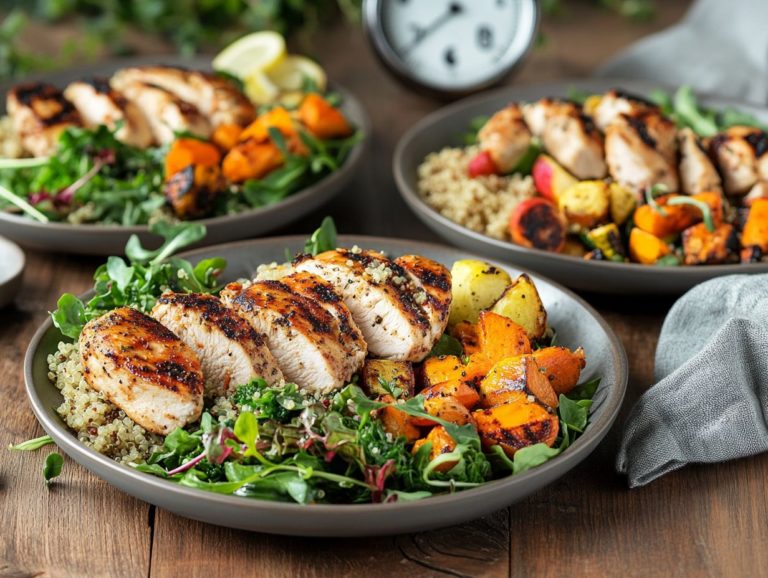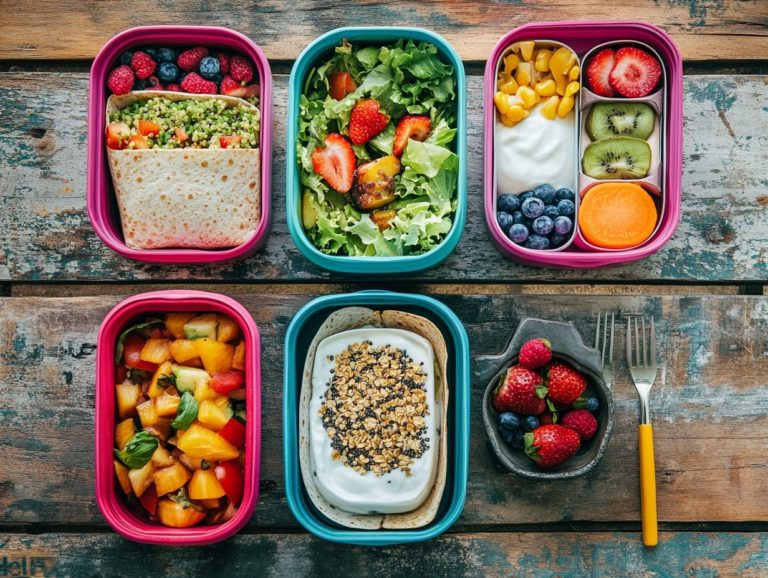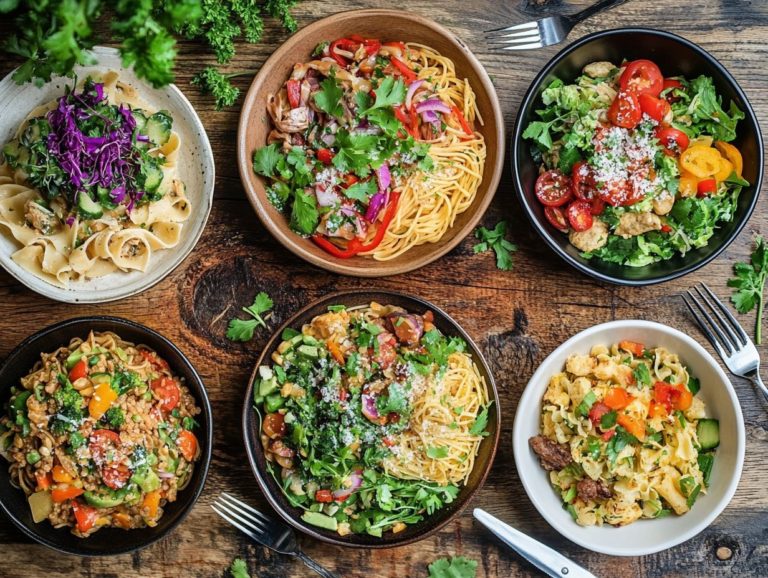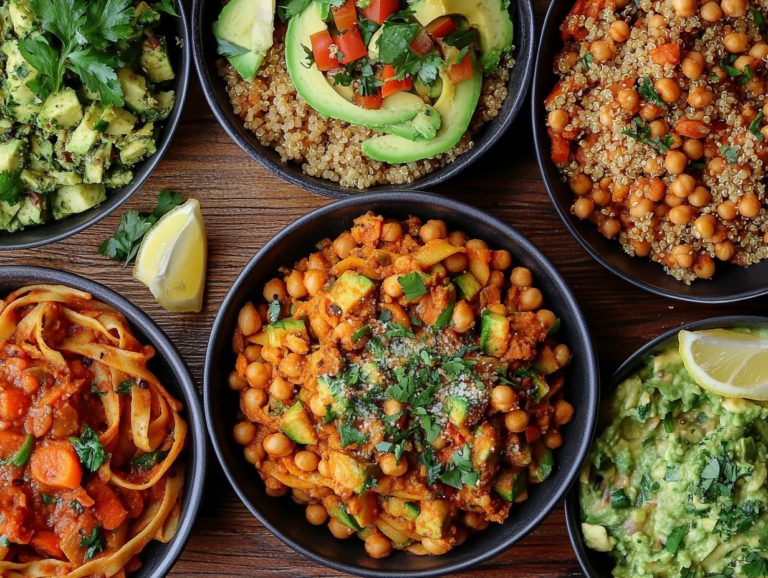5 Tasty High-Fiber Recipes to Incorporate
Looking to elevate your fiber intake while savoring delightful meals? This article offers five exquisite recipes that are not only high in fiber but also bursting with flavor.
From a hearty High-Fiber Breakfast Bowl to a satisfying Avocado and Black Bean Wrap, these dishes are designed to keep you energized throughout your day.
Delve into the advantages of a high-fiber diet, discover how much fiber you should strive for, and gather tips to seamlessly weave more fiber into your meals.
Discover nutritious options that cater to a variety of dietary preferences!
Contents
- Key Takeaways:
- 1. High-Fiber Breakfast Bowl
- 2. Avocado and Black Bean Wrap
- 3. Quinoa and Vegetable Salad
- 4. Lentil and Vegetable Soup
- 5. High-Fiber Fruit Smoothie
- Why Is It Important to Incorporate High-Fiber Foods into Your Diet?
- Frequently Asked Questions
- What are some tasty high-fiber recipes to incorporate into my diet?
- Why is it important to incorporate high-fiber recipes into my diet?
- How much fiber should I aim to consume in a day?
- Can I still enjoy tasty meals while increasing my fiber intake?
- Are there any other benefits to incorporating high-fiber recipes into my diet?
- Can I modify these recipes to fit my dietary restrictions?
Key Takeaways:
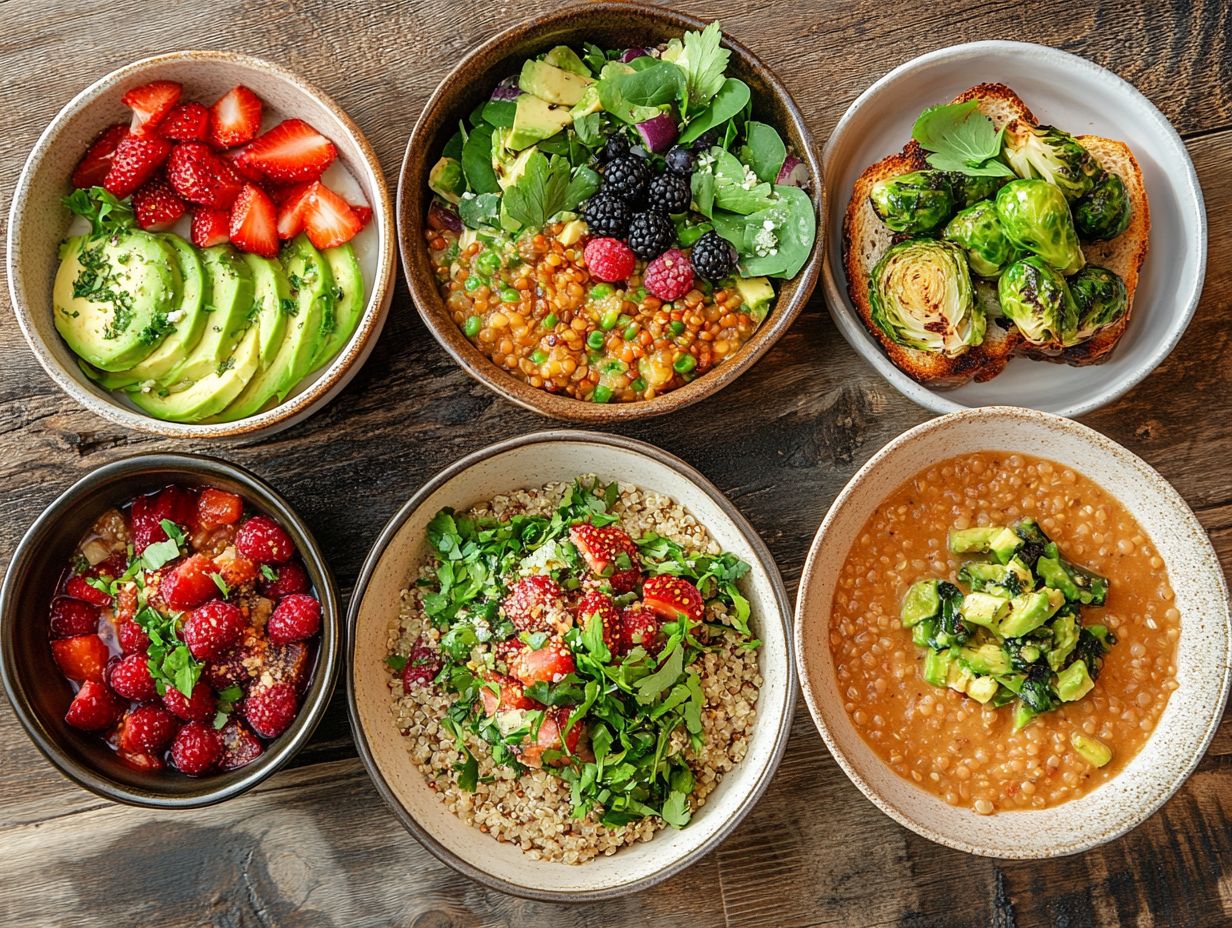
- Start your day off with a high-fiber breakfast bowl to keep you full and energized.
- Incorporate avocados and black beans into a wrap for a tasty and fiber-rich lunch option.
- Add quinoa and a variety of vegetables to your salads for a high-fiber and nutritious meal.
1. High-Fiber Breakfast Bowl
Start your day off right with a High-Fiber Breakfast Bowl that beautifully combines healthy ingredients like chickpeas and roasted vegetables. This powerhouse dish helps your digestion and keeps you energized and satisfied in the morning.
Picture this: a base of cooked quinoa or farro, both excellent sources of fiber. To really elevate the nutritional profile, consider adding roasted sweet potatoes, bell peppers, and zucchini.
Not only do they add vibrant color to your bowl, but they also pack in essential vitamins. Toss in a generous portion of chickpeas for a protein boost; this ensures that every bite is filling and beneficial for your digestive health.
For an effortless morning, batch-cook the grains and vegetables in advance; this way, assembling your breakfast during those hectic mornings becomes a breeze.
Feel free to get creative with your toppings! Add some creamy avocado, a sprinkle of seeds, or a dollop of Greek yogurt for extra richness.
Fiber-rich foods do wonders for digestion and help maintain a healthy weight by promoting that lovely feeling of fullness. This breakfast bowl aligns seamlessly with dietary guidelines, making it the perfect choice for anyone aiming for a wholesome start to the day.
2. Avocado and Black Bean Wrap
This Avocado and Black Bean Wrap is your go-to high-fiber meal option, effortlessly blending the creamy richness of avocado with the protein-packed goodness of black beans. It s a quick and nutritious choice for a snack or a light lunch that keeps your fiber goals in check.
By putting together this delightful wrap, you can easily include a variety of high-fiber ingredients that enhance flavor and elevate your overall health. Tossing in some fresh spinach or kale introduces a burst of vitamins.
A sprinkle of lentils boosts the fiber content even more, providing an excellent source of plant-based protein. Don t forget to add other crunchy vegetables like diced bell peppers or shredded carrots; they not only add texture but also enrich the nutrient profile.
With every bite, this wrap becomes a fiber powerhouse, aiding digestion and promoting satiety, helping to keep those pesky cravings at bay throughout the day.
3. Quinoa and Vegetable Salad
Indulge in a refreshing Quinoa and Vegetable Salad, a delightful blend of fiber-rich ingredients featuring quinoa as the base, enhanced by a vibrant array of colorful vegetables. This savory dish is perfect for your meal prep or a quick weeknight dinner.
Not only does this vibrant salad excite the palate, but it also offers an impressive array of health benefits. Quinoa stands out as a complete protein, providing all nine essential amino acids, making it an exceptional choice for anyone following a plant-based diet.
When you add crisp bell peppers, nutrient-dense spinach, and crunchy cucumbers, you create a rich source of vitamins and minerals. With its low-calorie count and high fiber content, this salad boosts your digestion and keeps you feeling great!
It s the ideal choice for those aiming to maintain a balanced diet, appealing to food lovers who seek both flavor and nutrition in every bite.
Try these dishes this week and feel the difference!
4. Lentil and Vegetable Soup
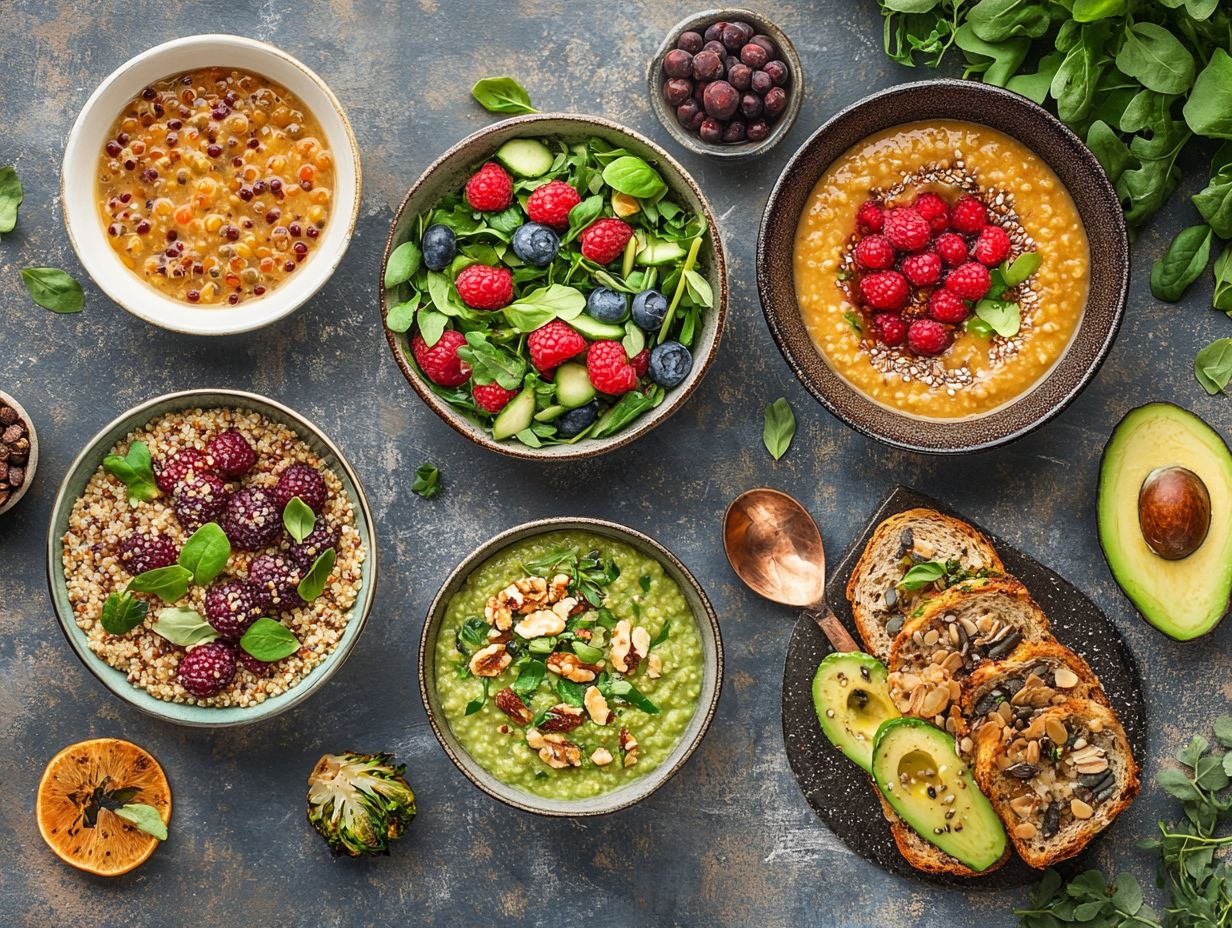
Lentil and Vegetable Soup is your go-to comfort food. This high-fiber dish melds hearty lentils with a vibrant array of vegetables. It’s the perfect nutritious meal for those cozy evenings or a satisfying option for meal prep throughout the week.
Start by saut ing onions, garlic, and your favorite spices in a drizzle of olive oil until aromatic. Then, add diced carrots, celery, and bell peppers. Let them soften before introducing rinsed lentils and vegetable broth.
If you prefer a hands-off approach, simply transfer this mixture into a slow cooker and let it simmer for several hours easy as pie!
Lentils are not just tasty; they re a powerhouse of fiber that promotes gut health and aids in weight management by keeping you feeling full. This makes the soup both nourishing and a smart choice for a balanced lifestyle.
5. High-Fiber Fruit Smoothie
A High-Fiber Fruit Smoothie isn t just a delicious and refreshing drink; it s a powerhouse of fiber-rich goodness. Fiber is a type of carbohydrate that your body can t digest, helping you feel full and supporting digestion. By blending fruits and vegetables, you can create a quick meal or nutritious breakfast that aligns perfectly with your daily fiber intake goals.
With antioxidant-packed berries and nutrient-dense spinach, this smoothie becomes a smart choice for anyone aiming to elevate their overall wellness. To amplify the fiber content, consider adding oats or chia seeds for an extra boost.
For those with dietary restrictions, there are plenty of options to keep it inclusive. Swapping in dairy-free alternatives like almond or oat milk makes it suitable for vegan diets. Using avocado instead of bananas delivers a creamy texture without sacrificing health benefits.
Ultimately, this smoothie is a far healthier choice than traditional desserts or snacks, offering essential nutrients without added sugars.
Why Is It Important to Incorporate High-Fiber Foods into Your Diet?
Incorporating high-fiber foods into your diet is essential for maintaining optimal health. These foods offer numerous benefits, from improving gut health and supporting your weight loss efforts to helping you meet your daily fiber intake goals. By doing so, you can effortlessly achieve a balanced, nutrient-rich diet.
Research indicates that sufficient fiber intake not only aids in digestion by promoting regular bowel movements but also plays a key role in weight management. It enhances satiety, making you feel fuller for longer, which helps reduce overall calorie intake.
Studies from the National Institutes of Health link a fiber-rich diet to reduced risks of heart disease and certain cancers. Additionally, fiber can stabilize blood sugar levels, lowering the risk of type 2 diabetes.
By adding a variety of fiber-rich foods such as fruits, vegetables, legumes, and whole grains to your meals, you can enjoy these health benefits while relishing a diverse and satisfying diet.
What Are the Benefits of a High-Fiber Diet?
A high-fiber diet brings a wealth of benefits, including improved digestion, enhanced gut health, effective weight loss, and a reduced risk of chronic diseases. It s a cornerstone of healthy eating and dietary guidelines you certainly want to embrace.
This nutritional powerhouse not only helps you feel fuller for longer, curbing pesky snack cravings, but it also plays a crucial role in regulating blood sugar levels. For those managing diabetes, the impact of fiber on maintaining steady glucose levels cannot be overstated.
Incorporating fiber-rich foods think lentils, beans, whole grains, and delightful fruits like apples and berries can significantly benefit your heart by lowering cholesterol levels.
Dietitian reviews consistently emphasize these advantages, underscoring the importance of weaving a variety of fiber sources into your daily meals for optimal wellness and effective disease prevention.
Start incorporating fiber-rich foods today to boost your health!
How Much Fiber Should You Be Consuming Daily?
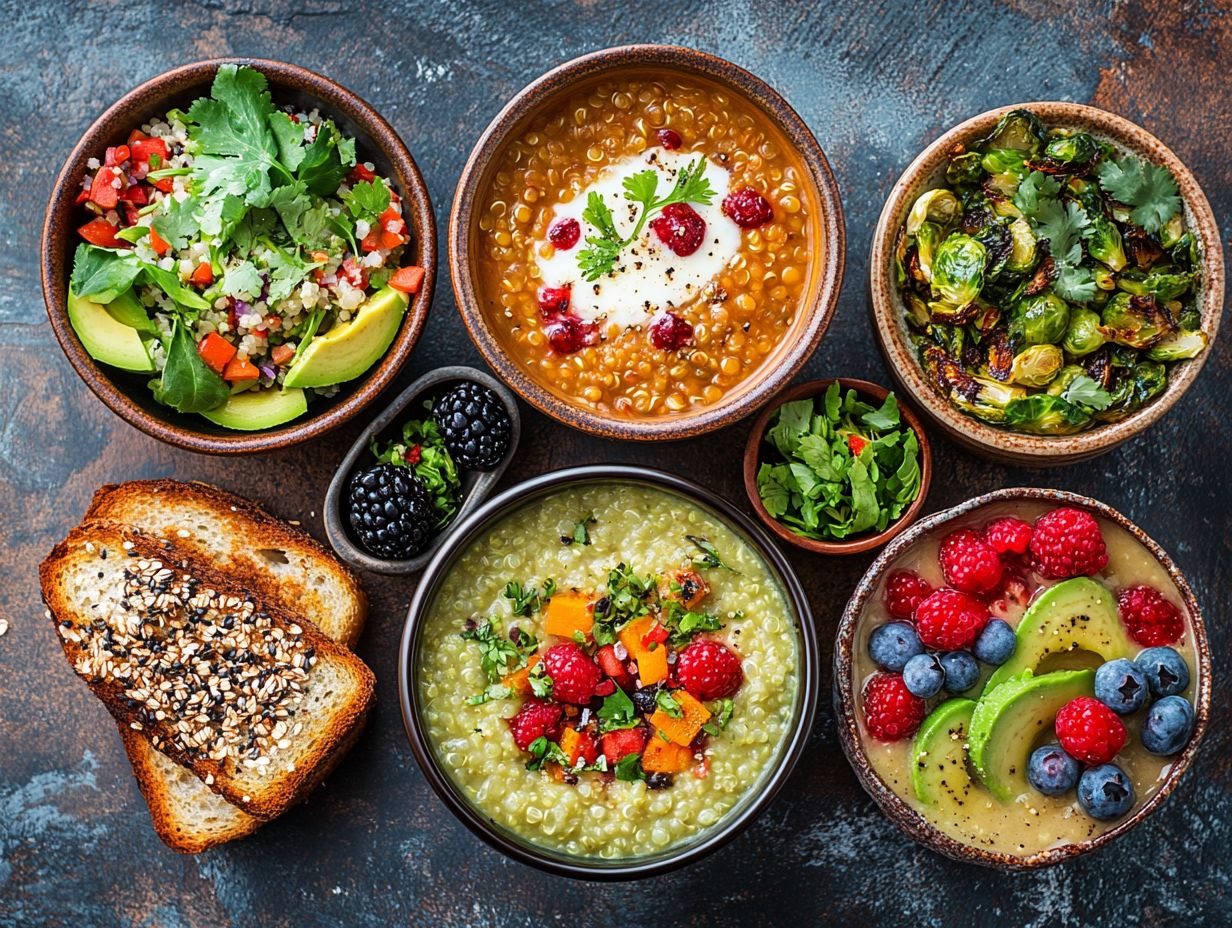
The recommended daily fiber intake varies based on age and gender. Generally, adults should aim for between 25 to 38 grams of fiber each day to meet their fiber goals and maintain optimal health.
For children, fiber needs can differ significantly, typically ranging from 14 to 31 grams, depending on their age and sex, as their digestive systems are still developing. Seniors can benefit greatly from incorporating fiber into their diets to promote regular bowel movements, with some experts suggesting a target of at least 30 grams daily.
Registered dietitians often recommend starting by including more whole grains, fruits, and vegetables in meals while gradually increasing fiber intake to avoid any gastric problems. Simple strategies like adding a tablespoon of chia seeds to smoothies or choosing brown rice instead of white can significantly impact your ability to meet these fiber goals.
What Are Some Other High-Fiber Foods to Incorporate into Your Diet?
In addition to enjoying legumes and whole grains, you can increase your fiber intake by incorporating a diverse array of fiber-rich foods like fruits, vegetables, nuts, and seeds into your diet. This promotes healthy eating habits and elevates your overall nutrition.
Among the standout choices are Brussels sprouts, sweet potatoes, and chickpeas, each bringing unique health benefits to the table. Brussels sprouts are amazing sources of fiber; they re also loaded with vitamins C and K, making them a fantastic addition to any meal. Sweet potatoes, with their delightful sweetness, deliver essential nutrients and are perfect for roasting or mashing. Chickpeas are incredibly versatile; toss them in salads, stir them into soups, or blend them into creamy hummus.
Incorporate these foods into your recipes to boost fiber consumption, leading to better digestion and a greater sense of satiety.
What Are Some Tips for Increasing Fiber Intake?
To effectively boost your fiber intake, consider implementing practical strategies that can seamlessly elevate your meals. Choose high-fiber ingredients for every dish you prepare and plan your meals to include fiber-rich foods like legumes and vibrant vegetables.
Don t shy away from experimenting with various cooking techniques to make fiber-rich foods more enticing. For example, roasting Brussels sprouts or saut ing kale can significantly enhance their flavors, turning them into delightful culinary experiences.
Meal ideas such as quinoa salad, lentil soup, or overnight oats are nutritious and quick to prepare, allowing you to savor them throughout the week. It s wise to introduce fiber gradually into your diet to minimize any gastric problems, giving your body the chance to adjust smoothly. Keeping a food diary can also be invaluable, helping you track your fiber intake and identify what suits you best.
Start today and feel the difference!
How Can These Recipes Be Modified for Dietary Restrictions?
Modifying high-fiber recipes to suit dietary restrictions is entirely within your reach. By substituting ingredients with vegetarian options, gluten-free selections, or allergen-free alternatives, you can ensure that everyone enjoys fiber-rich meals while adhering to their specific dietary guidelines.
For example, if you re navigating gluten intolerance, simply swap out traditional whole wheat pasta for quinoa or brown rice noodles. You’ll still reap those essential fiber benefits. For those embracing a vegan lifestyle, incorporating lentils or chickpeas in place of animal proteins not only boosts the fiber content but also adds a delightful texture to your dishes.
Remember, as you make these adjustments, it s vital to keep your meals flavorful and nutritious. Experimenting with spices and fresh herbs can truly elevate your dining experience. By meeting dietary requirements while maintaining a high fiber intake, you can create meals that are both enjoyable and health-conscious.
Frequently Asked Questions
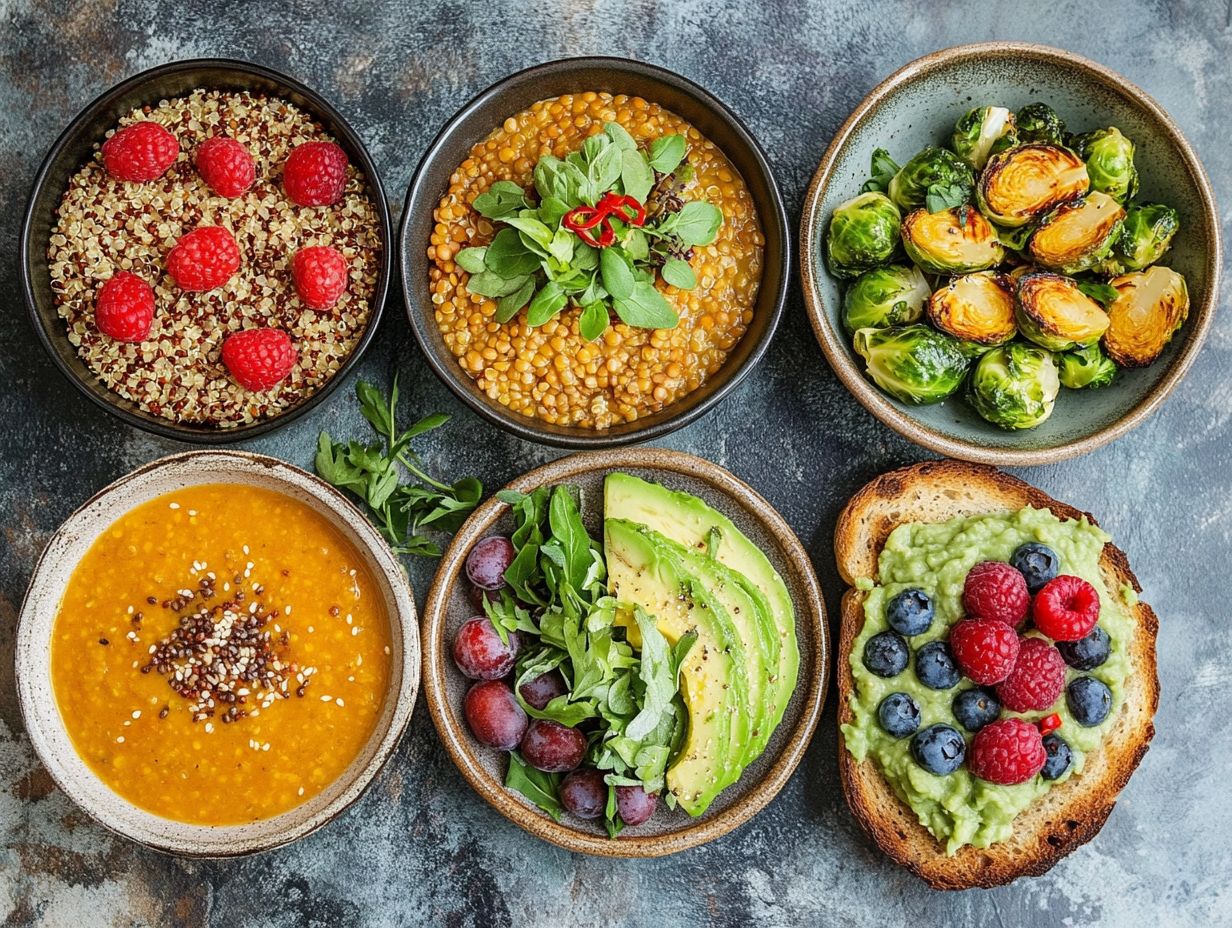
What are some tasty high-fiber recipes to incorporate into my diet?
- Lentil and Vegetable Soup: This hearty soup is packed with fiber-rich lentils and vegetables. It s a healthy and satisfying meal.
- Quinoa and Black Bean Salad: Quinoa is a great source of fiber. Combined with black beans, fresh veggies, and a zesty dressing, it’s delicious!
- Baked Sweet Potato with Black Beans and Avocado: This simple dish combines fiber-rich sweet potato with black beans and healthy fats from avocado.
- Whole Grain Pasta with Roasted Vegetables: Roasted vegetables add flavor and texture to this high-fiber pasta dish. It s a delicious option for your next meal.
- Chickpea and Vegetable Curry: This flavorful curry is loaded with fiber-rich chickpeas and spices. It s nutritious and satisfying!
Why is it important to incorporate high-fiber recipes into my diet?
Fiber plays a vital role in digestive health. It helps keep you regular and feeling full, aiding in weight management.
How much fiber should I aim to consume in a day?
Women should aim for 25 grams, while men should aim for 38 grams of fiber daily. Most people fall short, so adding high-fiber recipes is the perfect way to meet your needs.
Can I still enjoy tasty meals while increasing my fiber intake?
Absolutely! You can find plenty of delicious recipes that are high in fiber. Incorporate whole grains, legumes, and veggies for tasty, satisfying dishes.
Are there any other benefits to incorporating high-fiber recipes into my diet?
A high-fiber diet can reduce the risk of chronic diseases like heart disease, diabetes, and certain cancers.
Can I modify these recipes to fit my dietary restrictions?
Yes! These recipes are versatile. You can substitute gluten-free pasta, use vegetable broth, or omit certain ingredients as needed.
Start cooking these delicious high-fiber meals today and feel the difference!


